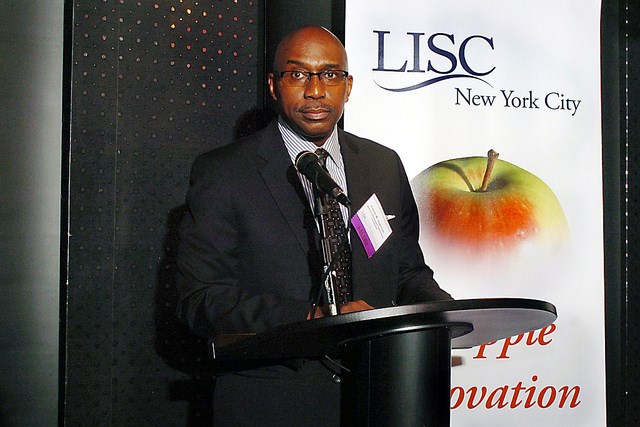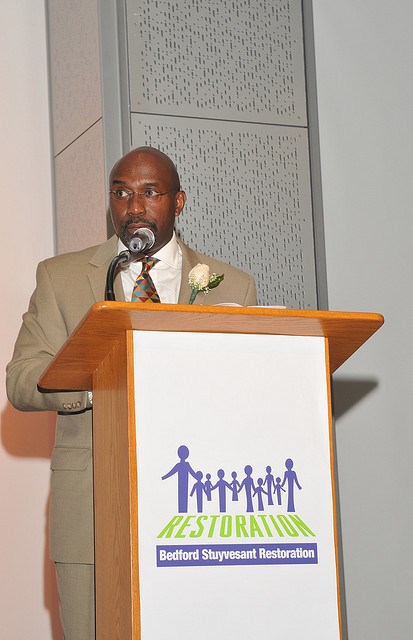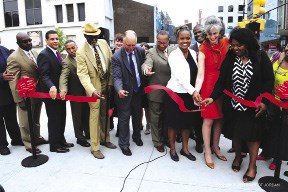
Bedford Stuyvesant Restoration Corporation has been serving the Bedford-Stuyvesant community for nearly fifty years, providing Brooklynites with a variety of resources and services. The Brooklyn Reader recently sat down with Restoration's President and CEO Colvin Grannum to get an overview of the organization's current priorities and directions.
Grannum was born and raised in Brooklyn, hailing from what is now called Clinton Hill. However, when he was growing up, those parts were known as Bed-Stuy and according to him, "People thought of it then they way people think about Brownsville now."
Attending Brooklyn public schools until college, Grannum received his undergraduate degree from University of Pennsylvania and his law degree from Georgetown University. On his return to New York Grannum did work for both the Dinkins and Giuliani administrations and in 1995, he and Fred Lucas, the pastor of Bridge Street Church, founded Bridge Street Community Development Corporation. Coming on board to Bedford Stuyvesant Restoration Corporation in 2001 as President and CEO, Grannum can attest to the changes in the community, as well as Restoration's relevance throughout the years.
Part of Restoration's relevance may be attached to its uniqueness. Grannum made note of how that makes the organization stand out to him. "I think it is a very unusual, unique community-based organization," he said. "It's a community based organization that has a national profile and there is not that many of those. And also it's, as far as I know, the oldest black-controled, or black-led non-profit. So it's the oldest and largest. Combine those two things and that makes it unique."

Also unique about Restoration is how it has remained relevant despite how the Bedford Stuyvesant neighborhood has changed over the years. Bedford-Stuyvesant has had an influx of new residents and investors, changing the neighborhood's reputation from once feared to the place to be. While the change in reputation has its benefits, it also comes with its own set of problems.
"The problem now is not how to attract investment; the problem is how do you manage investment or shape investment so that the benefits of the investment accrue to long-standing residents and to people who live across the economic spectrum," explains Grannum.
He continues, "There is a real danger in Bedford-Stuyvesant of economic segregation geographically and economic polarization. It used to be that black, poor people, and not just poor, but low income, working class people, and lower moderate income people were spread across the community because they were living in a full range of housing stock in the community both low density and higher density housing. Today, that's changing and the lower density housing is increasingly being occupied by far more affluent population and lower income people are being displaced from that housing stock."
Grannum believes that Restoration has the tools needed to help the community combat this issue of economic polarization. He explains how in the past fiscal year, Restoration had placed more than 300 unemployed people in jobs. Along with that, Restoration has given people financial coaching and signed them up for income supports such as Food Stamps.
Restoration feels that these efforts will promote household stability and enable these households to become platforms for further economic growth. "The whole idea is to build skills so that people can earn more money and have more stable households, so that children can learn and improve their academic outcomes."

Restoration is also looking into an education initiative involving the creation of community schools. Grannum says, "There is no question in my mind that a key to community stability is high quality schools. New York really hasn't been following that model because our students go all over the place to go to school. I think that has harmful effects for community building. To have strong communities, we need strong schools that are the center of those communities. Exploring the community schools model might have the benefit of building stronger communities, but we have to have a high quality school."
Tackling all these issues at once, in addition to maintaining other programs, sounds overwhelming, but Grannum enjoys that about Restoration. "There's just a whole bunch of things that happen here, also what this place represents, that makes it a great place for me to work. We have great aspirations. We really want to grow, and we really want to push to become more essential to the lives of people and to have meaningful participation with residents in improving their lives."
Grannum continues, "I think it is also important to us to demonstrate that a minority-led group can be first-tier in every way, in terms of financial management, in terms of program outcomes, etc because there sometimes seems to be some question about the capacity of minority led groups and whether they can be competitive. And so it's very important to me that we face up to that challenge."
With all that Restoration has lined up on top of the programming it already has in place, the organization seem to be prepared to take on the challenges that come with a changing community.



